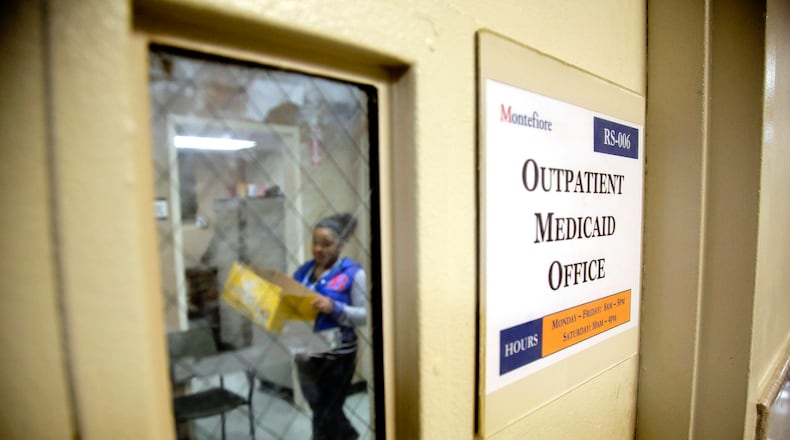Approval for the requirements, which can be also be met by schooling or other exemptions, is still pending. The work requirements were previously approved in 2019 under President Donald Trump’s first term in office. Former President Joe Biden’s administration reversed the approval in 2021.
A decade after Ohio expanded Medicaid, the percentage of Ohioans who did not have health insurance dropped more than 60%, according to the Health Policy Institute of Ohio.
“There is a chance that the state would see a reversal of that progress,” said Amy Rohling McGee, president of the Health Policy Institute of Ohio.
Employment, health linked
Proponents of work requirements for the expansion group want to help those Ohioans get the ball rolling on getting employed, often citing open jobs on OhioMeansJobs.com.
“I believe just as we are helping these folks get the health care they need, we also need to be helping them get the work or training they need to rejoin the workforce and help fill some of the 150,000 jobs currently listed on the OhioMeansJobs website,” said Clark County Sen. Kyle Koehler, R-Springfield, in his sponsor testimony of Senate Concurrent Resolution 5.
Employment is linked to improved health, according to Maureen Corcoran, director of the Ohio Department of Medicaid.
“With almost 90% of individuals served by Medicaid in managed care, the plans will work with individuals who are not otherwise deemed to be exempt or already meeting the Work and Engagement Requirement to ensure that they have the tools and supports they need to comply with the waiver,” Corcoran said.
Unpaid caregivers could fall through the cracks
Providing unpaid care to children and family members not able to take care of themselves is another reason why some Medicaid members may not be employed. While some may be able to retain coverage, others may not.
Of about 17.8% of Medicaid members who reported leaving work in 2023, 18.1% of them said they left due to childcare responsibilities, according to the Ohio Medicaid Assessment Survey.
Also in 2023, 35.5% of respondents to the Ohio Medicaid Assessment Survey said they were not working because they were being a caretaker.
“This means that these respondents may end up without health coverage or need to limit their caretaker responsibilities, including paying for childcare or a home health aide or assisted living for older parents, in order to work,” Rohling McGee said.
Some parents may be eligible for the Covered Families and Children eligibility group if the household has an income up to 90% of the federal poverty level and one or more children younger than 18 years old in the household, Rohling McGee said.
“However, caregivers who are not working and do not fit that eligibility criteria may end up without health coverage or need to limit their caretaker responsibilities, including paying for child care or a home health aide if caring for a parent, in order to work,” Rohling McGee said.
A ripple effect across the economy, workforce
With uncertainty about whether federal tax cuts will reduce federal funding for Medicaid, Ohio’s current state budget bill includes a provision that could terminate the expansion group entirely if federal funding falls under 90% for that group.
“While Ohio may see savings from reducing coverage for people enrolled in Medicaid, reducing coverage will also come with costs to the state, as well as lost revenue,” Rohling McGee said.
If the expansion group gets reduced in membership or cut entirely, the state could lose revenue generated by the tax and franchise fee on managed care plan revenues, as well as other income tax and sales tax revenue generated through the provision of health care to these enrollees, said Rohling McGee.
Cuts to Medicaid, coupled with other possible cuts to the Supplemental Nutrition Assistance Program (SNAP), could cause a ripple effect across states’ economies, according to the Commonwealth Fund, a foundation focused on health care policy and research.
The Commonwealth Fund estimates states’ gross domestic products (GDPs) would go down by about $95 billion. The total economic output lost would be about $157 billion, and the average state’s reduction in its GDP for 2026 would be $1.9 billion, according to the foundation.
Health care jobs and other jobs that support the health care field could take a hit. Nationwide, about 888,000 jobs would be lost in 2026, including 477,000 health care jobs at hospitals, clinics, doctors’ offices, pharmacies and nursing homes, according to the Commonwealth Fund.
Health facilities, like rural hospitals and nursing homes, might close, limiting access even for those who remain insured. Another 411,000 jobs would be lost as the effects extend to other industries, such as retail, construction and manufacturing, the foundation said.
In Ohio, the Commonwealth Fund estimates losses of:
- $2.9 billion in federal funding
- $6.4 billion in the state’s economic output
- $3.8 billion of Ohio’s GDP
- 20,000 direct health care jobs
- 18,200 other jobs
- $573.2 federal tax revenue
- $260.5 state and local revenue
Hospitals in the region could feel the impact of reduced Medicaid coverage.
About 20.24% of Kettering Health’s payor mix in 2022 was from Medicaid, along with 47.97% from Medicare, 24.8% commercial insurance and the remainder from other sources, according to past audits available through the Municipal Securities Rulemaking Board.
Premier Health saw a similar payor mix in 2023 with 20.6% from Medicaid, 48.4% from Medicare, 29.6% from commercial insurance and rest from other sources, like self-pay and charity care.
Across the Bon Secours Mercy Health group, which has locations in Clark, Champaign, Warren and Butler counties, about 16.1% of its payor mix was from Medicaid, 37.1% from Medicare, 44.3% from commercial insurance and the remainder from other sources in 2024.
Medical debt
Decreased health coverage for low-income Ohioans could also increase medical debt and limit disposable income.
Nationwide, nearly one in 12 adults, or 20 million adults, owe medical debt totaling $220 billion, according to one analysis from KFF, a health care policy and research organization.
Medical debt decreased in states that expanded Medicaid access, according to researchers from Harvard and Stanford in a study published in the Journal of the American Medical Association.
“People may be less likely to have expendable income for things like food and housing because of increased medical costs without access to insurance through Medicaid,” Rohling McGee said.
Medicaid expansion provides financial protection by lowering out-of-pocket costs and preventing catastrophic medical expenses, she said. This, along with improved health due to access to care, helps keep them employed.
“In Ohio, Medicaid has played a crucial role in helping vulnerable households achieve greater economic security while improving access to necessary health care services,” Rohling McGee said.
About the Author

